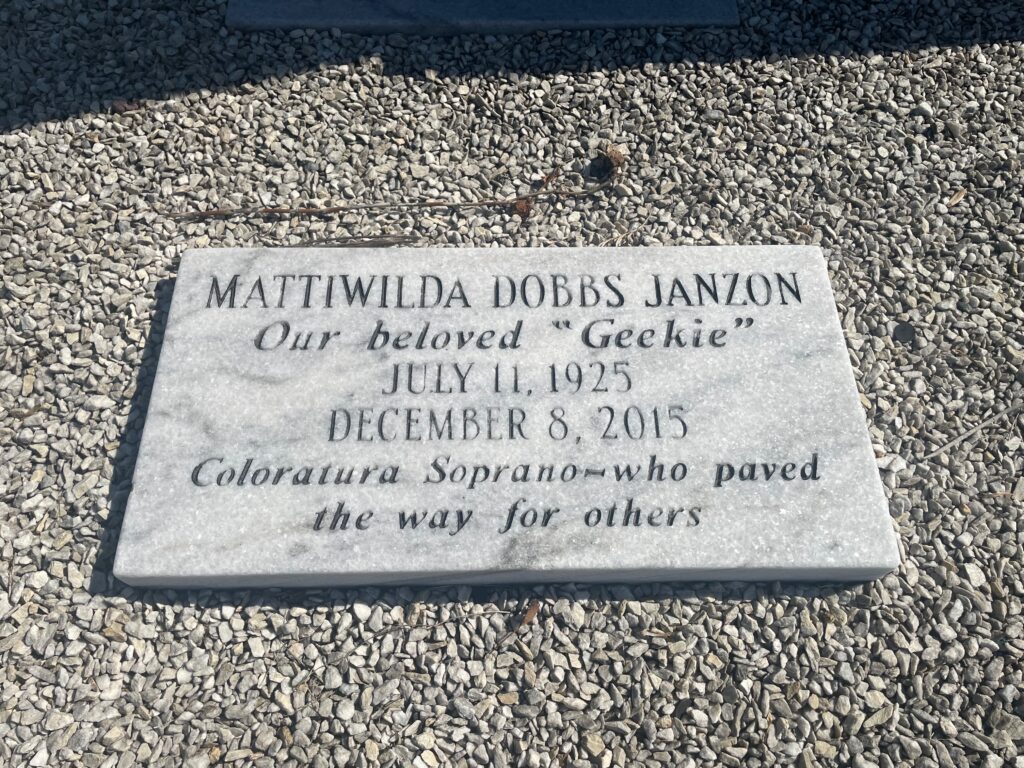Erik Visits an American Grave, Part 1,901
This is the grave of Mattiwilda Dobbs.

Born in 1925 in Atlanta, Dobbs grew up in the Black elite of the city. Her parents were relatively well off political activists and if there was anything that looked like an economic elite for Black people in the South of that time, it was in Atlanta, as limited as it still was. Her father, John Wesley Dobbs, was a legend in the Atlanta activist community and played a major role in building the infrastructure over the decades that later activists would build on the classic phase of the civil rights movement.
Mattawilda Dobbs was an excellent singer and was trained in classical music from the time she was a child, as well as in the high church choirs of that time and place. She then went to Spelman, perhaps the best college for Black women in the country at that time. She was actually a home economics major and thought about going into fashion design. But her teachers at Spelman told her that her talent for singing really was professional level with training and that she should pursue that. That her father pushed so hard for her to take these opportunities is very much to his credit. She later said that she would have turned down these chances if he had not supported her. She had some significant shyness to overcome as well, as she would later admit.
Another path could have happened. Martin Luther King Sr. tried to set her and his son Martin Luther King, Jr. up to be a couple. He thought they would make a good match and of course it would have been great for his position in the community. That did not work and the world might have been very different if it had.
Dobbs graduated from Spelman in 1946 as a dual major in music and Spanish. She then moved to New York and trained with the German soprano Lotte Leonard. She also, always practical, went to Columbia for a master’s degree in Spanish. At the very least, she could teach if the music career didn’t work out. But it worked out. She won a bunch of prominent musical scholarships and this allowed her to study music in Europe. She moved there in 1950 and lived much of the rest of her life in various parts of the continent. In 1951, she won the International Music Competition in Geneva, which was a major achievement and really made her career skyrocket. She played the biggest opera festivals in Europe for years and was largely based at London’s Royal Opera House on contract from 1953-58. That started with her playing Woodbird in Siegfried, so she was beginning with the biggest roles out there.
But she did perform in the U.S. as well and broke a lot of ground for Black opera performers through the 50s. While Marian Anderson was the first Black woman to play at the Metropolitan Opera and Robert McFerrin (father of Bobby) had been the first Black man just a few weeks later, Dobbs was the first Black artist to get a long-term contract, though I believe this was secondary to her British contract. She did play there 29 times over the next eight years, beginning I think in 1956. She had already broken the color barrier for the San Francisco Opera the year before that. She also started performing back in Atlanta by the late 60s, with the end of segregation at the city’s artistic venues after the passage of the Civil Rights Act of 1964. In fact, the Atlanta Municipal Auditorium was desegregated in 1961 after the student sit-in movement there led to the desegregation of public facilities and she sang there shortly after, in 1962, in a big triumphant moment for the city’s elite Black community.
Of course, all this meant Dobbs largely missed out on the civil rights movement that her family was deeply involved with, but her pioneering ceiling shattering work just being her amazing self was a serious contribution to the cause all on its own.
Dobbs spent most of her time in Europe until the mid 70s. She had married twice, both to European men. Her first husband was Spanish and died of a liver issue shortly after their marriage. Not sure if this was drinking related or something else. That was back in 1954. In 1957, she remarried, to a Swedish PR guy named Bengt Janzon and thus she took his name in her personal life, but not her professional life, as you see on the grave.
In 1974, Dobbs moved back to the U.S. to teach at the University of Texas. She was sick of performing by that time and wanted new challenges. Later, she taught at Howard, focusing her efforts on a new generation of Black opera singers. Her nephew was Maynard Jackson, the pioneering but ultimately pretty awful mayor of Atlanta who turned his back on the Black community after he won election to court rich and powerful whites and she sang at his inauguration.
Dobbs died in 2015. She was 90 years old. Upon her death, the New York Times noted that she was kind of forgotten in the world of Black opera singers and said it was two reasons. The first is that she recorded very little. The second is that she came between the traiblazing Marian Anderson and the immensely popular Leontyne Price, which makes sense.
Mattiwilda Dobbs is buried in South View Cemetery, Atlanta, Georgia.
If you would like this series to visit other Black opera singers, you can donate to cover the required expenses here. Jessye Norman is in Augusta, Georgia and Camilia Williams is in Danville, Virginia. Previous posts in this series are archived here and here. Incidentally, Leontyne Price lives.


